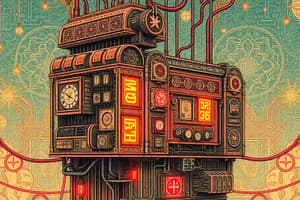Podcast
Questions and Answers
Which type of latch corresponds to the given logic diagram?
Which type of latch corresponds to the given logic diagram?
- Latch D with input EN (correct)
- Latch JK
- Latch SR X OP
- Latch SR with input EN
Which flip-flop corresponds to the provided truth table?
Which flip-flop corresponds to the provided truth table?
- None
- Flip-flop SR
- Flip-flop JK
- Flip-flop D (correct)
What type of counter does the logical diagram represent?
What type of counter does the logical diagram represent?
- Asynchronous 3-bit counter (correct)
- Asynchronous 2-bit counter
- Synchronous 2-bit counter
- Synchronous 3-bit counter
What type of device does the given time diagram represent?
What type of device does the given time diagram represent?
In a Flip-flop JK, what does the HIGH PRE and CLR inputs imply regarding the flip-flop state?
In a Flip-flop JK, what does the HIGH PRE and CLR inputs imply regarding the flip-flop state?
List the differences between asynchronous and synchronous counters.
List the differences between asynchronous and synchronous counters.
Complete the comments related to the truth table of the Flip-flop SR.
Complete the comments related to the truth table of the Flip-flop SR.
What is a characteristic of synchronous counters compared to asynchronous counters?
What is a characteristic of synchronous counters compared to asynchronous counters?
Flashcards
Latch Type
Latch Type
The type of latch in a given logic diagram from choices: D, D with EN, JK, SR, and SR with EN.
Flip-flop type from truth table
Flip-flop type from truth table
Identifying the flip-flop type (JK, SR, D, etc.) based on its truth table.
Flip-flop SR comments
Flip-flop SR comments
Describing the behavior and characteristics of an SR flip-flop based on its truth table.
Flip-flop JK HIGH PRE/CLR
Flip-flop JK HIGH PRE/CLR
Signup and view all the flashcards
D flip-flop diagram
D flip-flop diagram
Signup and view all the flashcards
Counter type from diagram
Counter type from diagram
Signup and view all the flashcards
Time diagram device type
Time diagram device type
Signup and view all the flashcards
Asynchronous vs. Synchronous Counter Differences
Asynchronous vs. Synchronous Counter Differences
Signup and view all the flashcards
Study Notes
Digital Systems - Study Notes
- Latches:
- A latch is a type of digital circuit that can be used to store a single bit of data.
- Different types include D latch, JK latch, SR latch.
- The image shows a D latch
- The output follows the input, but is latched (stored) once set.
- Flip-flops:
- Flip-flops are a type of digital circuit that can be used to store a single bit of data.
- Flip-flops can change state on positive or negative edges of a clock signal.
- Common types are JK, SR, D, identified by diagrams.
- Input and output signals are shown.
Flip-Flop Inputs and States
- PRE/CLR Inputs (Flip-Flop JK):
- These are control inputs.
- When both PRE and CLR are high, no change in the output.
- Asynchronous inputs.
- The output is affected without waiting for a clock edge.
Counters (Specific Example types in list)
- Synchronous Counters:
- Clock signals applied to every flip-flop.
- All flip-flops change state at the same time.
- Asynchronous Counters:
- Clocks are sequentially applied to each flip-flop.
- State changes occur in cascade/sequential manner.
- Diagram of flip flops and clock signals.
- Delays are dependent on previous state and not the clock.
- Specific Examples of Counter Types (Diagram):
- 3-bit synchronous counter.
- 4-bit asynchronous counter.
Diagram of Timing
- Type of Device (Based on Timing Diagram):
- The timing diagrams from the image show a counter.
- The specific counter type is a 4-bit asynchronous counter.
- Diagram shows the state transitions (changes) as a response to input pulses.
- Different components in the counter and the order in which the states change.
Studying That Suits You
Use AI to generate personalized quizzes and flashcards to suit your learning preferences.




